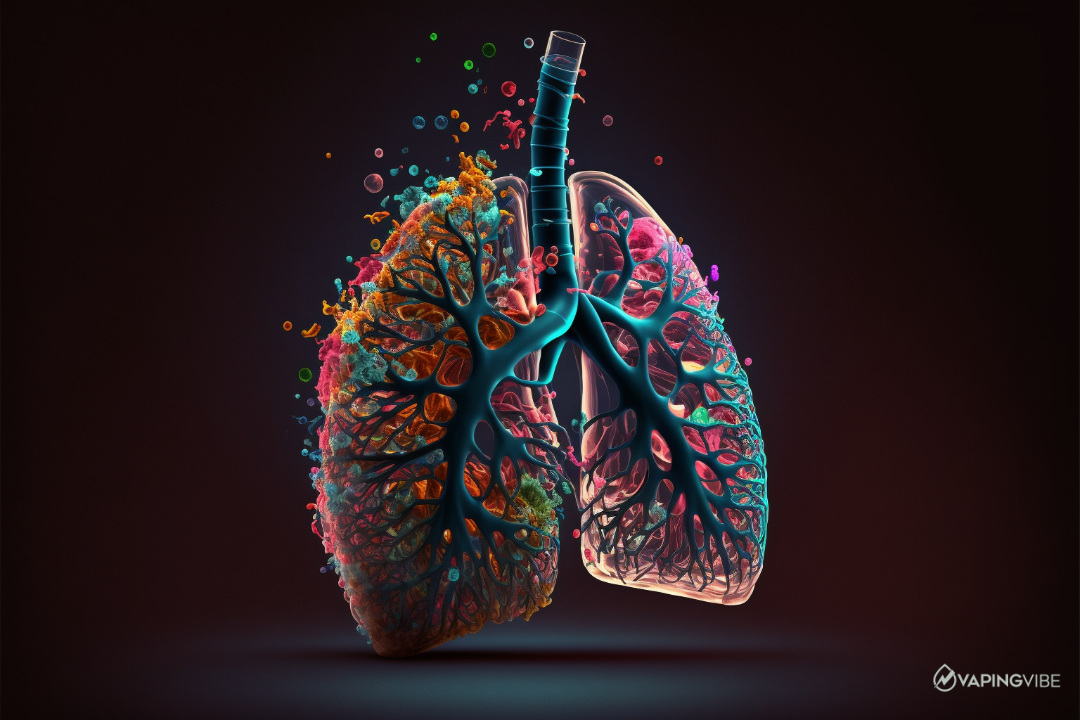SHOW SUMMARY
What You Need to Know
- Popcorn lung is not caused by vaping
- No confirmed cases of popcorn lung have been reported in individuals who vape
- Vaping can aid in smoking cessation
What is Popcorn Lung?
Popcorn lung, also known as bronchiolitis obliterans, is a rare lung disease that is characterized by the formation of scar tissue in the lungs. This lung tissue scar can obstruct the flow of air, making it difficult to breathe. It is important to note that popcorn lung is not a form of lung cancer.
There is a potential association between a chemical called diacetyl. Diacetyl is a flavor enhancer that is commonly used in the production of microwave popcorn and other foods, which is how the disease got the name called “popcorn lung”.
However, it is also found in other products such as e-cigarettes, and is used in other industries such as the chemical and pharmaceutical industry. Further research is needed to confirm the link between diacetyl and popcorn lung and to determine the exact cause of the disease. Despite the association, it’s important to note that the majority of the people exposed to diacetyl do not develop bronchiolitis obliterans, it’s still a rare lung disease.
Although lung transplants are currently the only known cure for popcorn lung, it is important to note that the procedure itself can also cause the disease. In fact, bronchiolitis obliterans syndrome (BOS) is the most common cause of chronic lung transplant rejection.

What Causes Popcorn Lung?
The condition of bronchiolitis obliterans, commonly called “popcorn lung”, earned its nickname from a group of microwave popcorn factory workers who developed the lung diseases. These workers had been exposed to inhaling diacetyl, a chemical used to give popcorn a buttery flavor, while on the job. It is important to note that the use of e-cigarettes has not been linked to the development of popcorn lung.
It is worth noting that popcorn lung can be caused by a variety of factors, and not just diacetyl exposure. The condition can occur as a result of an infection that damages the lungs or from inhaling chemicals that irritate the lungs and cause damage. In some cases, it can also occur idiopathically, meaning the cause is unknown. It’s important to note that it is a rare disease, and many people exposed to the chemical diacetyl don’t develop bronchiolitis obliterans.

What is diacetyl?
Diacetyl, also known as 2,3-butanedione, is a naturally occurring chemical compound found in fermented products such as alcoholic drinks and cultured milk products, as well as in some fruits and tobacco. It is used as a flavoring in processed foods due to its buttery taste and ability to enhance sweet flavors.
However, its use has been heavily regulated after it was linked to the flavorings related lung disease bronchiolitis obliterans, also known as “popcorn lung,” which was found in workers at popcorn factories who were exposed to high levels of diacetyl fumes. The FDA considers diacetyl and related flavoring chemicals, such as acetyl propionyl, to be safe for ingestion, but inhaling large quantities of them can cause lung damage.
The Truth About Popcorn Lung and Vaping
There has been concern that vaping may also lead to the development of popcorn lung because some e-liquids contain diacetyl. However, it is essential to note that not all e-liquids contain diacetyl, and the levels present are typically much lower than those found in the popcorn factory where popcorn lung was first identified. Additionally, while some studies have shown a link between diacetyl exposure and popcorn lung, more research is needed to understand the risk entirely.
While there is concern about the potential link between vaping and popcorn lung, more research is needed to understand the risk. In the meantime, vapers can reduce their risk by choosing e-liquids that do not contain diacetyl and practicing good lung health habits, such as avoiding smoking and exposure to other pollutants.

Vaping and Popcorn Lung: Separating Fact from Fiction
The concern that vaping may also lead to the development of popcorn lung has led to misinformation and confusion. It is crucial to separate fact from fiction regarding this topic.
Fact: Nobody has been diagnosed with bronchiolitis obliterans or popcorn lung from vaping.
No smoker has been diagnosed with popcorn lung from cigarette smoking either.
Fact: Some vape juice e-liquids contain diacetyl.
Some e-liquid manufacturers used diacetyl as a flavoring agent.
Fact: High levels of diacetyl have been linked to popcorn lung.
Studies have shown that inhaling high levels of diacetyl can cause damage to the bronchiolitis obliterans, leading to popcorn lung.
Fact: The levels of diacetyl in e-cigarettes are lower than in traditional cigarettes.
Studies have shown that the levels of diacetyl in e-cigarettes are generally much (100x) lower than those found in traditional cigarettes.
Fiction: All e-liquids contain diacetyl.
Diacetyl is no longer used by reputable e-liquid manufacturers in their vape juice products. See our guide to the best vape juice brands, e-liquid flavors and types.
Fiction: Vaping is the main cause of popcorn lung.
Several factors, including smoking and exposure to certain chemicals and pollutants, can cause popcorn lung. Therefore, it is unclear to what extent vaping may contribute to the development of popcorn lung.
Note:
In the United Kingdom, the use of diacetyl as an ingredient in e-cigarette liquids was banned under the European Union Tobacco Products Directive (TPD) in 2016. The ban was put in place to protect consumers from the potential health risks associated with inhaling diacetyl, which has been linked to popcorn lung. As a result, e-liquids sold in the UK are not allowed to contain diacetyl. However, it’s important to note that the ban only applies to e-liquids, not other products or industries that may use diacetyl.

Symptoms and Causes of Popcorn Lung
It is characterized by symptoms such as coughing, wheezing, and shortness of breath. In severe cases, it can lead to difficulty breathing and lung damage and may require a lung transplant.
Symptoms of popcorn lung typically develop gradually and may include:
- A dry cough that doesn’t go away
- Shortness of breath, especially during physical activity
- Wheezing
- Chest tightness
- Fatigue
Diacetyl is a chemical used in some food products, and e-cigarettes as a flavoring agent. However, inhaling high levels of diacetyl has been linked to damage of the bronchioles, which can lead to the development of popcorn lung.
Other known causes of popcorn lung include exposure to chemicals such as ammonia, chlorine and smoking. Popcorn lung can also be caused by certain medical conditions such as sarcoidosis and rheumatoid arthritis.
The Impact of Popcorn Lung on Lung Function
The impact of popcorn lung on lung function can be significant, as the condition causes inflammation and scarring of the bronchioles, making it difficult for air to flow through the lungs. This can lead to difficulty breathing, especially during physical activity.
The damage caused by popcorn lung can be irreversible and lead to a decline in lung function over time. In severe cases, it can lead to a decreased ability to perform daily activities and require a lung transplant.
Symptoms typically develop gradually and may include:
- A dry cough that doesn’t go away
- Shortness of breath, especially during physical activity
- Wheezing
- Chest tightness
- Fatigue
It’s important to note that the effects of popcorn lung on lung function may vary from person to person, depending on factors such as the severity of the condition, the length of time it has been present, and the overall health of the individual.
Early diagnosis and treatment are crucial to slowing the progression of the disease and preserving lung function. Therefore, if you are experiencing any of the symptoms described above, it is vital to see a doctor to receive a proper diagnosis and treatment.
How to Reduce the Risk of Popcorn Lung when Vaping
There are several steps vapers can take to reduce their risk of popcorn lung when vaping:
- Choose e-liquids that do not contain diacetyl: Not all e-liquids contain diacetyl, and vapers can avoid e-liquids that contain this chemical to reduce their risk.
- Avoid high levels of inhalation: Inhaling high levels of diacetyl can increase the risk. Therefore, vapers should avoid deep inhaling, especially when using e-liquids containing diacetyl.
- Use high-quality e-cigarettes: High-quality e-cigarettes manufactured to industry standards can reduce the risk of inhaling a harmful chemical, including diacetyl.
- Practice good lung health habits: Avoiding smoking, exposure to other pollutants, and maintaining a healthy lifestyle can help reduce the risk of popcorn lung.
- Regular check-ups: Regular lung health check-ups can help to detect any issues early on and to treat them before they become severe.
It is important to note that while these steps can help reduce the risk of popcorn lung when vaping, more research is needed to understand the risk entirely. Therefore, if you are experiencing symptoms of popcorn lung, it is vital to see a doctor to receive a proper diagnosis and treatment.
Additionally, it’s also essential to keep in mind that while diacetyl exposure has been linked to popcorn lung, other factors can contribute to the development of the condition, such as smoking and exposure to inhaling toxic substances such as other chemicals and pollutants. Therefore, reducing the risk of popcorn lung when vaping may also involve reducing exposure to these other risk factors.

Conclusion: Does vaping cause popcorn lung?
There is currently no scientific evidence to support the claim that vaping causes popcorn lung, also known as bronchiolitis obliterans. While some news stories have suggested a link, no studies have found a connection between vaping and popcorn lung. Additionally, cigarette smoke contains significantly more diacetyl than any vaping product, yet smoking is not associated with popcorn lung.
In fact, the few reported cases of popcorn lung have been found in workers at popcorn factories who were exposed to high levels of diacetyl fumes. While the risks associated with smoking, such as lung cancer, heart disease, and chronic obstructive pulmonary disease (COPD), are well-known, popcorn lung is not among them. Additionally, vaping does not involve combustion and therefore does not produce tar or carbon monoxide and contains only a small fraction of diacetyl found in cigarette smoke. Therefore, there is no evidence to suggest that vaping causes popcorn lung.

